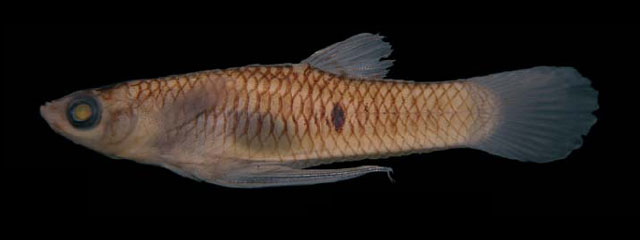| Poeciliidae (Poeciliids), subfamily: Poeciliinae |
| 2.41 cm SL (male/unsexed); 3.32 cm SL (female) |
|
benthopelagic; freshwater |
| South America: small coastal drainages flowing into Baía de Paranaguá in Paraná State, Brazil. |
|
Dorsal soft rays (total): 8-8; Anal soft rays: 8-10; Vertebrae: 31-32. Can be diagnosed by the following combination of characters: the female urogenital papilla
curved to the right, located laterally; border of the anal aperture in contact with the first anal-fin ray or very close to it; absence of the right hook and presence of the left one; gonopodial appendix asymmetrical, its halves different from each other, right half wider than left one; rounded tip of the hook on left half of gonopodial appendix; hook on left appendix very small; absence of a caudal peduncle spot; presence of a wide and square-shaped lateral spot in large specimens; lateral spot in adult females elliptical to roundish, but never forming a vertical bar; lateral spot always present and evident not covering more than the length corresponding to two scales length in horizontal or vertical directions (Ref. 76852).
Description: Pectoral fin with 5-6 branched rays; longitudinal series of scales 28-30; transverse series of scales 7 (Ref. 76852). |
|
|
Least Concern (LC); Date assessed: 07 November 2018 Ref. (130435)
|
| harmless |
Source and more info: www.fishbase.org. For personal, classroom, and other internal use only. Not for publication.

